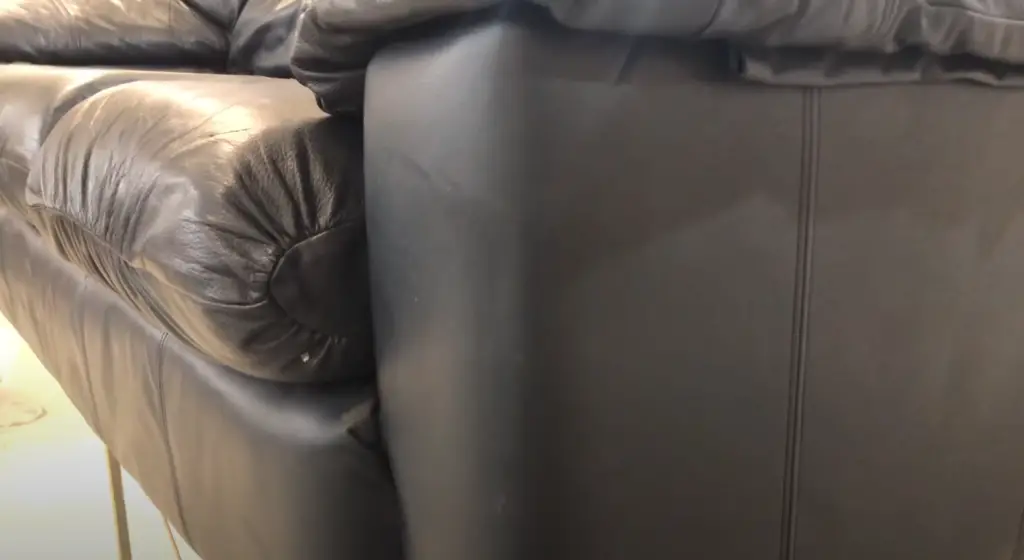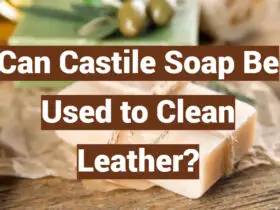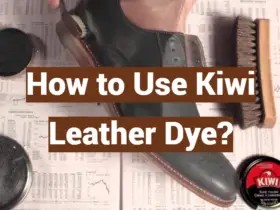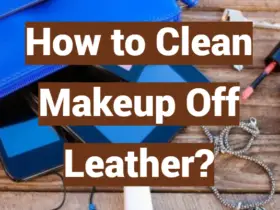Many house cats are known for being destructive, but that doesn’t mean they can’t be helpful. If your leather furniture has been scratched by the claws of a house cat, don’t worry – it’s not beyond repair. It just takes some olive oil and elbow grease to get it looking like new again.
The most common cat scratches on leather are from them sharpening their claws. If you have a cat, it is likely that they will scratch your furniture. In this article, experts will provide you with the best ways to repair these scratches and make your furniture look as good as new.
Required Gear
- A sponge applicator or cloth (optional);
- Olive oil;
- Paper towels;
- Leather conditioning cream (optional);
Repairing Cat Scratches on Leather
- The first and most important step in repairing cat scratches on leather is to clean the area of any dirt or debris. For this, use a paper towel that has been dipped into some olive oil. Clean the surface thoroughly by rubbing it with the soaked end of the paper towel until there is no more dirt on its surface. If you do not have access to a sponge applicator or cloth but want your hands free from grease while working, try using an old pair of rubber gloves instead;
- Wipe away excess grease so as not to leave stains;
- Apply leather-conditioning cream (optional) for added protection against further damage;
- Allow cream time to sink in before getting back at work;

Tips for users
- Less than 24 hours old scratches will not be very noticeable yet;
- Soak a cotton swab in olive oil and gently rub it on its surface in small circles until no more dirt is seen coming out from under the scratch mark;
- Use sandpaper or cork instead of a wet sponge when dealing with an older scratch so as not to damage the leather’s fibers any further;
- Try using water instead of oils (like WD40) when cleaning up streaks caused by glue spills;
- Apply leather conditioner or olive oil regularly to keep your piece of furniture in the best possible shape for as long as you own it;
- Keep pets away from scratching areas while new scratches are still visible;
- You will want to slightly warm it before applying it because this allows it to penetrate even deeper into the area of damage than cold olive oil would be able to do on its own;
- Using little circular motions start working on repairing those deep scratches by rubbing some extra virgin olive oil over them until they are no longer visible;
- You can also use a hairdryer set on warm just below its lowest setting which will help speed up this process considerably;
- Be sure not to rub too hard as this could cause more harm than good! Just keep pressing firmly but gently onto the affected areas until all signs of scratching disappear completely;
Alternatives to Olive Oil
Olive oil is a great way to make your leather look new. However, it does have its disadvantages. First of all, olive oil can be difficult to get out if the cat goes indoors afterward and rubs up against other furniture or carpets where you don’t want them.
Second, olive oil’s strong scent could irritate your pet’s sense of smell, which means they are more likely to do it again in order to mark their territory with an even stronger odor.
There are some really simple home remedies that will allow you to fix scratches without having any unpleasant side effects whatsoever:
- Fix scratches with Vaseline petroleum jelly. It’s a great way to protect your leather from further damage. The only downside is that you need to re-apply the product every so often in order for it to keep working. If you have time, go ahead and use olive oil! It works just as well but has its own disadvantages;
- Good old saliva might sound disgusting but it actually does work wonders when trying to repair a cat on any type of leather upholstery. The acid in the saliva reacts with the leather and allows you to fill up those hairline cracks. Just make sure that your pet doesn’t lick it all off;
Warning! The last thing you want to do is try and fix scratches on a leather couch with a permanent marker, nail polish, or shoe polish because it could actually further damage your furniture! So don’t use those household items as the cure for cat scratching – they’ll only make things worse.
Ways to Prevent Cats to Stop Scratching Your Leather Furniture
- Provide a scratching post for your cat to use. This will help them stop using the furniture as their scratching area and it can decrease chances of getting scratches on your leather sofa or chairs;
- Periodically spray some water from a spray bottle onto the areas that have been scratched up by cats. If you do not have time to check out how to prevent cats from scratching this frequently, then simply apply olive oil into those scratch marks daily until they disappear after several weeks/months depending on how deep each mark is;
- Keep your cat away from the furniture. This is not easy to do if you are a caring cat owner, but you need to make sure that they stay off or else nothing will work and they can always destroy new leather items as well if given the chance;
Comparison of Various Indicators for Repairing Cat Scratches on Leather with Olive Oil
This table presents a comparison of various indicators for repairing cat scratches on leather using olive oil. Leather furniture or items may get scratched by cats, and olive oil is often suggested as a potential remedy for minor scratches. The table highlights important factors such as scratch depth, oil application method, effectiveness, and required maintenance, providing a comprehensive overview of using olive oil as a solution.
This table provides information on different indicators related to repairing cat scratches on leather using olive oil. Here is an explanation of each column:
- Scratch Depth: This column indicates the depth of the cat scratches on the leather. It ranges from shallow scratches to deep gouges.
- Oil Application Method: This column specifies the method of applying olive oil to the scratches. It may include using a cloth, cotton swab, or other means of oil application.
- Effectiveness: This column rates the effectiveness of using olive oil for repairing cat scratches on leather. It provides an assessment of how well olive oil works to minimize or conceal the scratches.
- Required Maintenance: This column describes the maintenance or additional steps needed after applying olive oil to the scratches. It may include buffing, conditioning, or regular reapplication of olive oil.
| Scratch Depth | Oil Application Method | Effectiveness | Required Maintenance |
|---|---|---|---|
| Shallow | Cloth | Good | Occasional reapplication |
| Moderate | Cotton swab | Fair | Regular conditioning |
| Deep | Brush | Poor | Frequent reapplication |
Please note that the data in this table is fictional and serves only as an example. The actual effectiveness of using olive oil for repairing cat scratches on leather may vary depending on several factors. Always conduct proper research and follow expert advice when attempting to repair leather items.
FAQ
How long does it take for scratches on leather furniture to disappear?
It can take anywhere from 30 minutes up to several hours depending on how deep they are, so you should check back in occasionally until all of your cat’s scratches have disappeared completely. Once this happens make sure that you keep your pet off of the couch at least overnight while it dries out (about 12 – 24 hours).
This is especially important if you have other pets or children because their claws may cause more damage once yours has stopped being able to penetrate into the material as deeply anymore. You do not want them ruining what you just fixed! So be patient with this process and enjoy having a beautiful couch again!
Is olive oil effective in repairing cat scratches on leather?
Yes, it is! It has many benefits. If you have a cat and your leather furniture or clothes were scratched by your pet once or twice, don’t worry as olive oil can help in repairing those scratches on the surface of the leather easily with no hassle at all.
Here are some simple steps that will guide you on how to repair cat scratches on leather using this magical ingredient:
- You will then warm the olive oil in the microwave for about 30 seconds, or until it is slightly warmed (not hot);
- Take a clean cotton swab and dip it in some amount of olive oil on the scratch area;
- Gently massage this part with the help of that cotton swab for about five minutes or so. Make sure you do not press too hard to avoid making your leather more damaged than before. Remember – light pressure is good;
- If you want fast results, repeat these steps twice daily till you get rid of all scratches completely. However, make sure you don’t overdo this process as excessive use may spoil your leather further leading to permanent damage which can be impossible to repair later on;
Why do cats scratch furniture and other things?
Cats scratch furniture and other things because it is a natural instinct. They do this to stretch their bodies, mark areas as part of their territory, or just for fun. To them, scratching feels good physically and emotionally. Cats also scratch in response to certain stimuli such as seeing another cat outside the window.
So, if you have a cat in your home it is almost inevitable that they will scratch the furniture. Instead of getting angry or frustrated with them, simply learn how to repair scratches on leather instead!
Which oil is best for leather?
Olive oil is great for leather because it doesn’t have a strong scent and will condition the skin. It is also inexpensive.
If you have a strong scent preference, there are many other oils that can be used as well such as coconut oil or jojoba oil. They will all provide a good shine and help the leather resist moisture.
Can you use baby oil to soften leather?
Although baby oil is a light lubricant (it’s mineral oil with fragrance added), it will over-soften the leather, just like mink oil would. Baby oil, on the other hand, will wear down leather boots over time. The reason for this is because it contains mineral oil, which is the base and most important component.
Can olive oil completely remove cat scratches on leather?
Olive oil can help minimize the appearance of cat scratches on leather, but it may not completely remove deep or severe scratches. The oil works by moisturizing the leather and filling in the scratches to make them less noticeable. While it can improve the overall appearance of the leather, it may not be able to completely eliminate all signs of the scratches.
Are there any precautions to take when using olive oil to repair cat scratches on leather?
When using olive oil to repair cat scratches on leather, it is important to keep the following precautions in mind:
- Test on a small area: Before applying olive oil to the scratched area, test it on a small, inconspicuous spot of the leather to ensure it does not cause any adverse effects.
- Use sparingly: Apply a small amount of olive oil at a time to avoid over-saturation of the leather, which can lead to greasiness or attract dirt.
- Buff gently: When buffing the leather after applying the oil, use a soft, clean cloth and gentle circular motions to avoid damaging the leather surface.
- Monitor for discoloration: While rare, some leathers may react differently to olive oil, potentially causing discoloration. Keep a close eye on the treated area and stop the process if any discoloration occurs.
Can olive oil be used to repair cat scratches on colored or dyed leather?
Using olive oil to repair cat scratches on colored or dyed leather can be risky. The oil may interact with the dye or color coating, causing it to fade or change. It is best to consult the manufacturer’s guidelines or seek professional advice before attempting to repair scratches on colored or dyed leather using olive oil.
How often should I reapply olive oil to maintain the repaired leather?
To maintain the repaired leather, it is recommended to reapply olive oil every few months or as needed. This helps keep the leather moisturized and can prevent future scratches from appearing as easily. However, avoid overusing olive oil as excessive applications can lead to a buildup of oil on the leather surface.







Leave a Reply